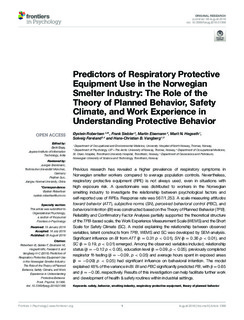| dc.contributor.author | Robertsen, Øystein | |
| dc.contributor.author | Siebler, Frank | |
| dc.contributor.author | Eisemann, Martin | |
| dc.contributor.author | Hegseth, Marit Nøst | |
| dc.contributor.author | Føreland, Solveig | |
| dc.contributor.author | Vangberg, Hans Christian Bones | |
| dc.date.accessioned | 2018-10-19T07:36:36Z | |
| dc.date.available | 2018-10-19T07:36:36Z | |
| dc.date.created | 2018-07-16T12:44:13Z | |
| dc.date.issued | 2018 | |
| dc.identifier.citation | Frontiers in Psychology. 2018, 9 1-12. | nb_NO |
| dc.identifier.issn | 1664-1078 | |
| dc.identifier.uri | http://hdl.handle.net/11250/2568772 | |
| dc.description.abstract | Previous research has revealed a higher prevalence of respiratory symptoms in Norwegian smelter workers compared to average population controls. Nevertheless, respiratory protective equipment (RPE) is not always used, even in situations with high exposure risk. A questionnaire was distributed to workers in the Norwegian smelting industry to investigate the relationship between psychological factors and self-reported use of RPEs. Response rate was 567/1,253. A scale measuring attitudes toward behavior (ATT), subjective norms (SN), perceived behavioral control (PBC), and behavioral intention (BI) was constructed based on the Theory of Planned Behavior (TPB). Reliability and Confirmatory Factor Analyses partially supported the theoretical structure of the TPB-based scale, the Work Experience Measurement Scale (WEMS) and the Short Scale for Safety Climate (SC). A model explaining the relationship between observed variables, latent constructs from TPB, WEMS and SC was developed by SEM-analysis. Significant influence on BI from ATT (β = 0.31 p < 0.01), SN (β = 0.36 p < 0.01), and SC (β = 0.19, p < 0.01) emerged. Among the observed variables included, relationship status (β = −0.12 p < 0.05), education level (β = 0.09, p < 0.05), previously completed respirator fit-testing (β = −0.09, p < 0.05) and average hours spent in exposed areas (β = −0.09) p < 0.05) had significant influence on behavioral intention. The model explained 48% of the variance in BI. BI and PBC significantly predicted PB, with β = 0.65 and β = −0.06, respectively. Results of this investigation can help facilitate further work and development of health & safety routines within industrial settings. | nb_NO |
| dc.language.iso | eng | nb_NO |
| dc.publisher | Frontiers Media | nb_NO |
| dc.relation.uri | https://www.frontiersin.org/articles/10.3389/fpsyg.2018.01366/full | |
| dc.rights | Navngivelse 4.0 Internasjonal | * |
| dc.rights.uri | http://creativecommons.org/licenses/by/4.0/deed.no | * |
| dc.title | Predictors of respiratory protective equipment use in the Norwegian smelter industry: The role of the Theory of Planned Behavior, safety climate and work experience in understanding protective behavior | nb_NO |
| dc.title.alternative | Predictors of respiratory protective equipment use in the Norwegian smelter industry: The role of the Theory of Planned Behavior, safety climate and work experience in understanding protective behavior. | nb_NO |
| dc.type | Journal article | nb_NO |
| dc.type | Peer reviewed | nb_NO |
| dc.description.version | publishedVersion | nb_NO |
| dc.source.pagenumber | 1-12 | nb_NO |
| dc.source.volume | 9 | nb_NO |
| dc.source.journal | Frontiers in Psychology | nb_NO |
| dc.identifier.doi | 10.3389/fpsyg.2018.01366 | |
| dc.identifier.cristin | 1597454 | |
| dc.relation.project | Norges forskningsråd: 245216 | nb_NO |
| dc.description.localcode | Copyright © 2018 Robertsen, Siebler, Eisemann, Hegseth, Føreland and Vangberg. This is an open-access article distributed under the terms of the Creative Commons Attribution License (CC BY). | nb_NO |
| cristin.unitcode | 194,64,90,0 | |
| cristin.unitname | Institutt for geovitenskap og petroleum | |
| cristin.ispublished | true | |
| cristin.fulltext | original | |
| cristin.qualitycode | 2 | |

